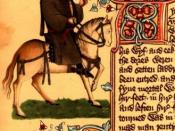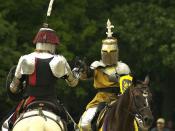Many changes were exposing themselves during the Middle Ages. Chaucer uses vivid charaterizations to represent these changes in society. He introduces these characters as "pilgrims" onn their way to the Cathedral in Canterbury. Through his depictions of the Knight and the Squire, Chaucer reveals the decline of the code of chivalry, the code which called for politeness on and off the battlefield. Chaucer also uses several ecclesiatical characters in order to demonstrate the corruption of the church, the nun being at the higheest echelon and the friar at the lowest. The Oxford cleric and Sergeant at the Law represent the emergence of education during such times. Though all of Chaucer's characters characters are fictional, he manipulates to get his point across about society's changes in the fourteenth century.
Chaucer's Knight is a perfect example of the decline of chivalry. He is at the top level between him and the Squire.
The knight represents chivalry at its best. He was true to the code and had the most respect for it. Chaucer reveals that (l.64-68) "And though so distinguished he was wise/ And in his bearing modest as a maid/ He never yet a boorish thing had said/In all his life to any come what might/ He was a true, a perfect gentle knight." His meekness also encourages the concept of him being chivalrous. His shabby tunic shows that as important a role he played in medieval society, he could still be lowly. His son on the other hand, was quite the opposite. The aquire defamed the name of chivalry with his rich attire. Although this squire does indeed represent the code of chivalry, he merely represents the negative side of it. With his lock of hair that "were curly as if they'd been pressed". It showed that in the area of humility he was weak.





